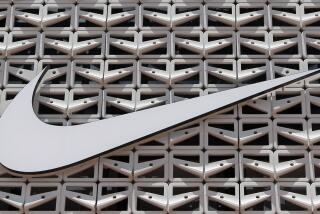Quiksilver is riding a wave of red ink
- Share via
Surf apparel company Quiksilver Inc. hasn’t given investors much to be stoked about in recent years.
The Huntington Beach company owns some of the biggest brands in action sports: Quiksilver, Roxy, DC and others. Yet it has lost money each of the last six years and is expected to post a loss this year too.
So, what’s the deal?
Analysts note a slowdown in the action sports industry, increased global competition and, perhaps, a loss of focus. And the company’s less successful brands hurt its performance.
Quiksilver sells its products at its own retail stores — it owned or licensed more than 800 stores worldwide as of April — and sells wholesale to major retailers as well.
Sales for its fiscal second quarter, which ended April 30, were down 5% from the same period last year as the company struggled to hold market share in a highly competitive industry.
The latest
Last month, Quiksilver unveiled a “multi-year profit improvement plan” aimed at increasing sales and reducing costs.
The company said it intended to cut sponsorships of athletes, spend more money on conventional advertising, focus on its bestselling brands — Quiksilver, Roxy and DC — and expand in Asia and Russia. It’s also closing underperforming retail stores and eliminating jobs.
“Our plan is designed to enhance the performance of our three flagship brands,” said Andy Mooney, Quiksilver’s chief executive. “We expect that the plan’s initiatives will, over time, result in significantly higher profitability, enhanced working capital efficiency, reduced overhead spending and an improved competitive position.”
Mooney, who was hired in January, has overhauled Quiksilver’s management team by appointing new directors of apparel, footwear, supply chain, marketing, licensing, retail and wholesale sales.
“I’m increasingly confident that the profit improvement plan developed by the management team is achievable,” Mooney said this month in a conference call with analysts.
“That confidence has been bolstered due to the caliber of executive talent now in place to execute the plan,” he said.
Accomplishments
The promise brought on by a new management team has attracted investors, who have driven Quiksilver’s shares up nearly 50% this year.
Analysts have praised the company’s efforts to turn profitable, saying a focus on its core brands should improve the bottom line.
“We have faith in new management’s ability to execute this plan,” said Dave King, an analyst with Roth Capital Partners. “These initiatives should lead to ... a much higher sustained profitability.”
Challenges
Where to begin?
The last time Quiksilver posted a profit was 2006. A survey by financial services firm Piper Jaffray & Co. found that Quiksilver’s brands trailed in popularity among teenagers, its core customer base.
“The company faces competition from other action sports brands, including Hurley, Vans, Reef, Volcom, Hollister, Billabong, Rip Curl, Etnies, O’Neill and others,” King said.
“Much of the company’s potential for success hinges on its ability to accurately predict consumer preferences and fashion trends,” he said. “We believe that the company’s failure to anticipate, identify and react in a timely matter to fashion trends could negatively affect its business.”
Analyst views
Three analysts rate the stock as a buy, six recommend holding it and one says investors should sell. They estimate the stock will reach $7.10 in 12 months.
“We believe management’s turnaround strategy is sound,” analyst Eric Tracy of financial services firm Janney Montgomery Scott said in a recent research note.
“Management’s plan to refocus on their three key brands is important to longer-term market share growth,” said Erinn E. Murphy, an analyst with Piper Jaffray.
More to Read
Inside the business of entertainment
The Wide Shot brings you news, analysis and insights on everything from streaming wars to production — and what it all means for the future.
You may occasionally receive promotional content from the Los Angeles Times.










